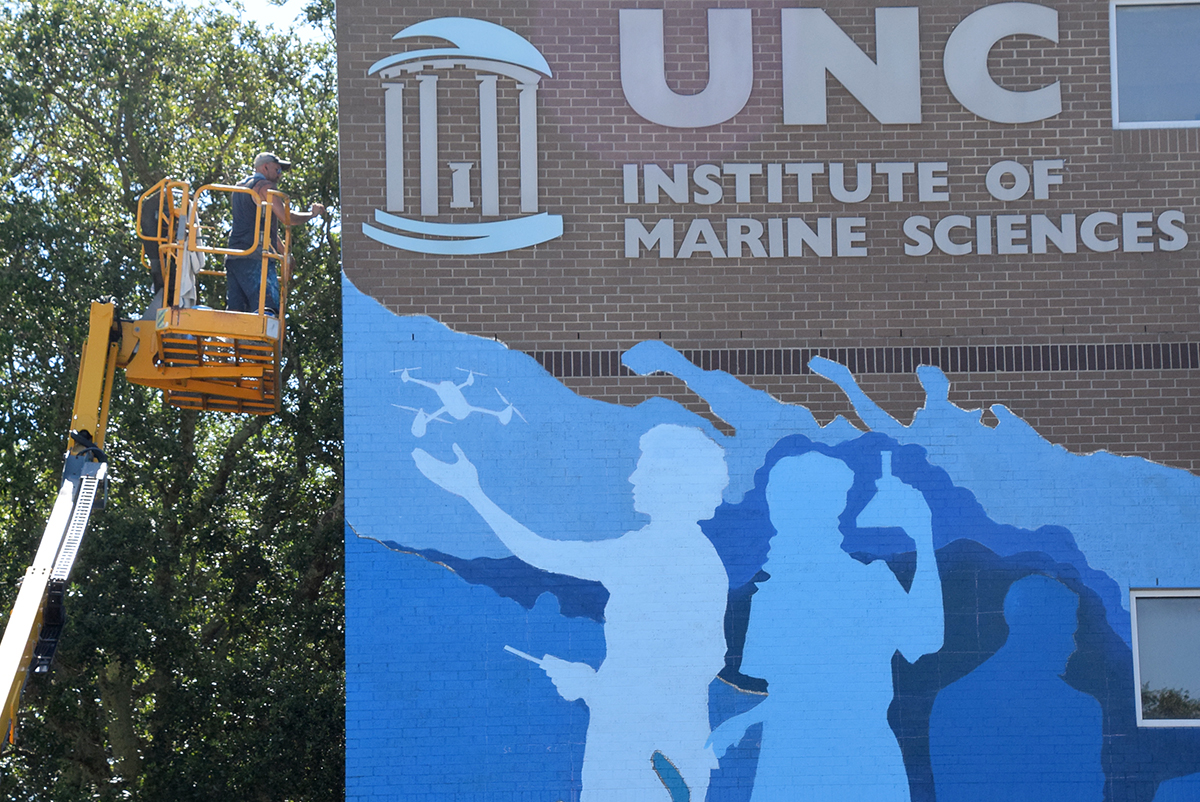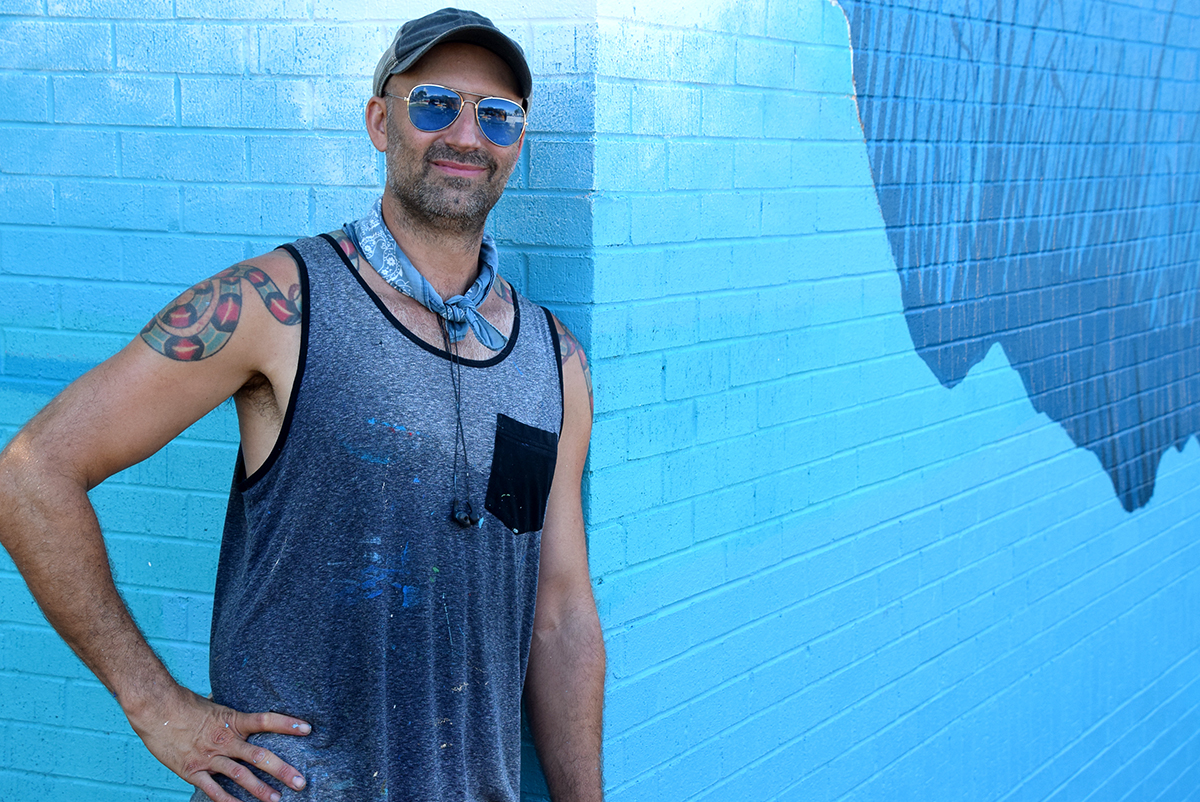
MOREHEAD CITY — Science, sustainability, stewardship and acrylic superpaint are being mixed and blended this week to create a highly visible, stories-high representation of what the University of North Carolina Institute of Marine Sciences means to coastal communities.
Max Dowdle of Hillsborough is the artist creating the three-story mural in process at the institute on Arendell Street. A muralist who has done similar project across the state, Dowdle was selected for this project after a national call for proposals.
Supporter Spotlight
Dowdle got started Friday chalking the outline of his vision and, as of Tuesday, work was proceeding ahead of schedule.
“Every once in a while, we get chased out by the rain but it kind of cools things down too, so it’s nice,” he said.
The acrylic superpaint is an industrial-grade exterior coating, and at the very least, Dowdle said, it’s rated for 10 years. “But I’ve had things last longer than that,” he said. He’ll then seal the finished mural with an anti-UV coating, as well as an anti-graffiti coating. “That adds a lot of lifespan. It evens out the surface as well as it gives it all one sort of finish.”
While it’s his concept, Dowdle isn’t doing all the work alone. Faculty and students from the institute and others, including volunteers from the Arts Council of Carteret County, high school students and mother-daughter charity teams have chipped in.
“It’s been a nice, big crew, and they’ve all been really awesome and really helpful. We’ve made short work of a lot of it,” he said.
Supporter Spotlight
The mural project — the brainchild of Libby O’Malley, the institute’s development manager — illustrates the diverse work done at the UNC research laboratory that has roots in Carteret County extending back to the 1890s and formal facilities here since the 1940s.

The mural is flowing in blue tones, as Dowdle noted Tuesday morning as he jumped from several feet above ground in a pair of aviators with blue lenses after coming most of the way down in the basket of a cherry picker that had been extended to near the top of the building.
“I use water a lot in my work,” he said. “I find it’s very organic. Everybody can have something that they can relate to with water, and so I find that it’s a nice access point for people. Also, growing up in Charleston, (South Carolina,) I was at the beach all the time, and I think it informs our work a lot.”
Related: Mural to mark UNC Institute of Marine Sciences’ 75 years
Gesturing at the sky above and Bogue Sound behind him, Dowdle said blue is just a great color to work with. “It’s, it’s calming, it’s just atmosphere, and I really enjoy that about it.”
But beyond pleasing hues, the mural depicts details of the coastal environment and the people who here.
“The idea is that it’s basically these frames in front of each other that are sort of stacked and they’re all delineated by the edge of coastal areas around here,” Dowdle said as he traced in the air the lines of his design. “And so, using that as my sort of initial superstructure, I then started thinking, ‘Well, let’s have it be more coastal,’ as it is down here closer to us on the ground. And it moves to deep water as we get farther up. So that’s why we’ve got the Capricorn up there, which is the ship the IMS uses — that’s what I’m working on today — and that’s out in the deep water.”
The frames wrap around the front corner of the building, depicting various marine life grouped according to their natural proximity to shore: sharks and rays and deep-water organisms that are studied at the institute up high, with ocean shorelines and inshore marshes with crabs and oyster beds closer in.
But it’s not just flora and fauna, as UNC Institute of Marine Sciences Director Rick Luettich noted.

“it seems to cover the various habitats we work in, from the coastal waters in to the inner nearshore, it covers that well. It has a North Carolina bent to it for sure,” Luettich said Tuesday. “If you’ve seen it since yesterday, you’ll see that very prominent on it are three figures, three silhouettes, which really is sort of the juxtaposition of people working in these habitats, and so that was what really resonated with me.”
The middle figure represents someone working in a lab. The figure at left represents someone working with a drone, “And that’s indicative of the new technologies that we’re working with, always looking to move forward in how we do research in the coastal zone,” Luettich said. The silhouette at the far right is holding a laptop, which again is a huge part of the work and research, he added, “dealing with data, and of course everything is computer driven.”
Prominently placing people in the painting brought all the elements together, Luettich said. About 60 to 70 work there during this time of year. In the fall, a dozen or more undergraduate students will study here. Sometimes the number totals close to 100.
About 30, the faculty and staff, are full-time residents. The graduate students, whose numbers total 15 to 20, generally live here year-round.
“They’re living here while they work on their graduate studies, and when they finish, they may or may not stay in the area,” Luettich said. But even those who leave have a lasting impact in the community, as is also the case with the Duke Marine Lab, North Carolina State University’s Center for Marine Sciences and Technology and the National Oceanic and Atmospheric Administration.
The universities’ and NOAA presence in eastern North Carolina has a huge impact, he added. “And its impact is indeed largely due to the people that are here that come and raise their families here and are just part of the community fabric.”
This “rich group of folks” has contributed in major ways to the North Carolina coast being a safer, more productive and sustainable place to live, Luettich said.
“In terms of leaving the mark of service to the state and through our work, we’ve been effective. I think there’s a lot of evidence of that,” he said.
But the public may not always be aware of the work that happens here. Communicating the institute’s presence started with a small sign out front, then a larger sign, and then 15 years ago, large lettering and the UNC Old Well logo were installed on the building itself. Still, more was needed.
O’Malley had the answer.
“She had the notion that we could use the end of the building and the side of the building that faces west to tell much more of a story of what we do at the lab,” Luettich said.

While the approval process was a challenge, it may not have been as daunting as the thought of selecting a design.
“Can we get a design that we will feel, really says what we want to say, given how big it’s going to be and the fact that we’re going to see it every time we show up? That was just a little scary,” Luettich said.
Dowdle’s submission put minds at ease.
“We had respondents from California to Florida to North Carolina — a lot of great ideas. The one that Max admitted was far and away the best one. It really stood out,” Luettich said.
The design also resonated with the faculty, Luettich said. He said the institute’s mission and research are a service to the state and its people and especially to eastern North Carolina.
“Most of the research work that goes on at the institute is designed to solve problems relative and relevant to eastern North Carolina. And we do a lot of that. That being said, I think that for years and years and years, most people in eastern North Carolina and Carteret County and in Morehead City drove by our facilities day after day and never really even knew that the university was there,” he said.
He described the mural as the culmination of 75 years of efforts to communicate a message that the science done here is broad and encompasses number crunching and it encompasses field and lab work, but also encompasses art.
“This is an opportunity to bring the right brain and the left brain together and kind of in a big way, point out all of the great things that are going on at the institute and also just simply welcome people to Morehead City,” he said.
Dowdle said his vision encapsulates how the people who work here perform their work and how their work is important to sustaining the coastal environment. Sustainability is important, he said.
“We only have the one planet, so it’s important to be good stewards of it,” he said.








